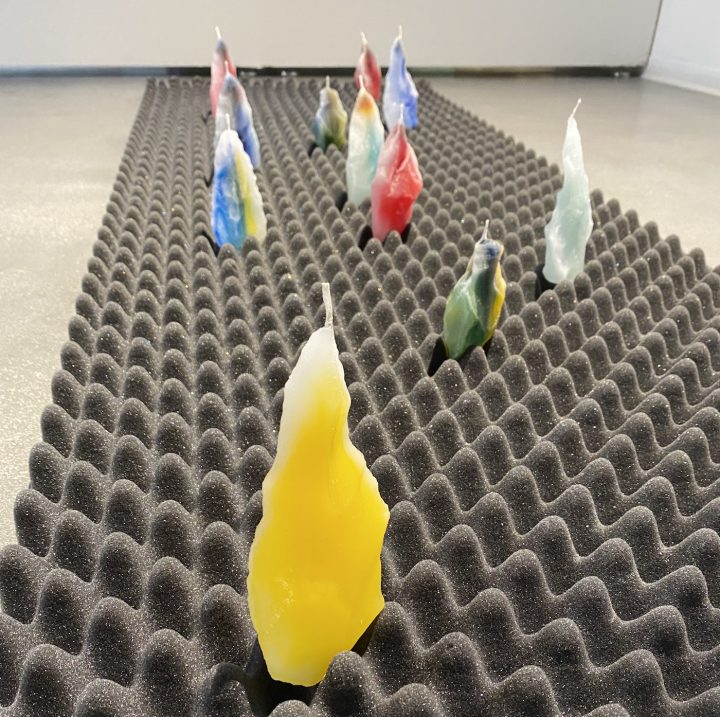
LOS ANGELES — Every spring and summer, MFA programs mount exhibitions to showcase the work of graduating students, offering audiences the opportunity to see the next wave of emerging artists before their work shows up in galleries and museums. As a result of COVID-19 protocols, many schools were forced to pivot to online presentations last year, or cancel or delay them. This season, some schools, like Otis College of Art and Design, opted to stick to online viewing rooms for graduate work, while others made the decision to stage in-person exhibitions with pandemic precautions in place. Two of those schools in the Los Angeles area are the USC Roski School of Art and Design and UC Riverside.
USC held its graduate MFA shows consecutively, offering each student a solo show in the gallery space of the new Roski Graduate Building in the Arts District. The venue allowed artists to create installations that took into account the space and how the audience moved through it, an experience that would have been hard to translate to the online realm. Within those parameters, the work varied widely, from painting to augmented reality. Although not always directly addressed, the specter of pandemic-born isolation and anxiety was present, either through intimate depictions of family and friends, or through screens that have framed our reality for much of the past two years.
UC Riverside staged the group show Bag of Cats 2, featuring work by four graduating MFA students (an update on Bag of Cats 1, a thesis show staged earlier this year). Held at downtown nonprofit space JOAN, the July exhibition was characterized by a notable coherence between artists, who cleverly and honestly explored themes of solidarity, generosity, and the various filters that mediate our perception.
* * *
Jiyoon Kim: twice a day by mouth, USC Roski

Jiyoon Kim takes mundane daily rituals, like beautification and pain management, and amplifies them, turning them into absurd, self-perpetuating machines or minimalist markers of entropy. In one work, a constantly running motor-driven cement-grinding wheel — modeled on a traditional Korean version (Kim is originally from South Korea) — grinds Advil tablets to dust. A wooden stick tied to the wheel makes a clacking noise as it revolves: meditative at first, maddening as it goes on. She also casts pills in burnt sugar, which slowly decompose into a glossy, black pool by the show’s end, aesthetically seductive but inert.
Rachel Zaretsky: Walking Along the Memorial Wall, USC Roski
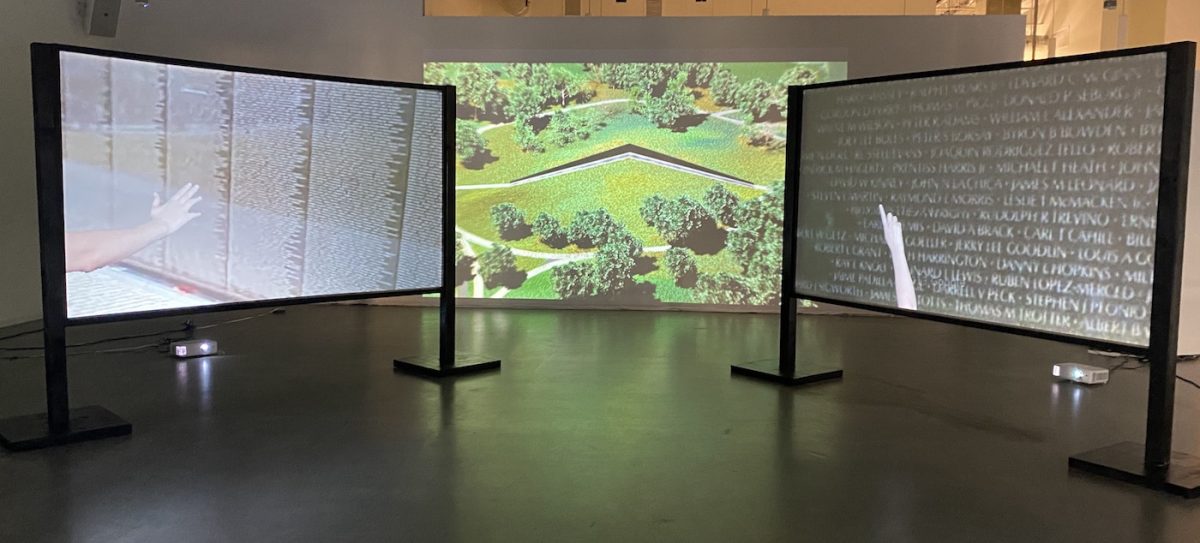
Rachel Zaretsky’s three-channel video installation captures the possibilities and limitations that living life online offers. Unable to travel during the pandemic, Zaretsky “visited” Maya Lin’s Vietnam Memorial purely through online portals like Google Maps, Trip Advisor, Instagram, and YouTube. From myriad firsthand digital accounts, she collaged together a composite experience of being at the site and walking the length of its stark black, granite V-shape, with her disembodied arm guiding the viewer. There’s a tension between the intimate, layered personal traces and the fact that Zaretsky was never able to experience the physical name rubbings or be near other visitors.
Danie Cansino: Sangre, USC Roski
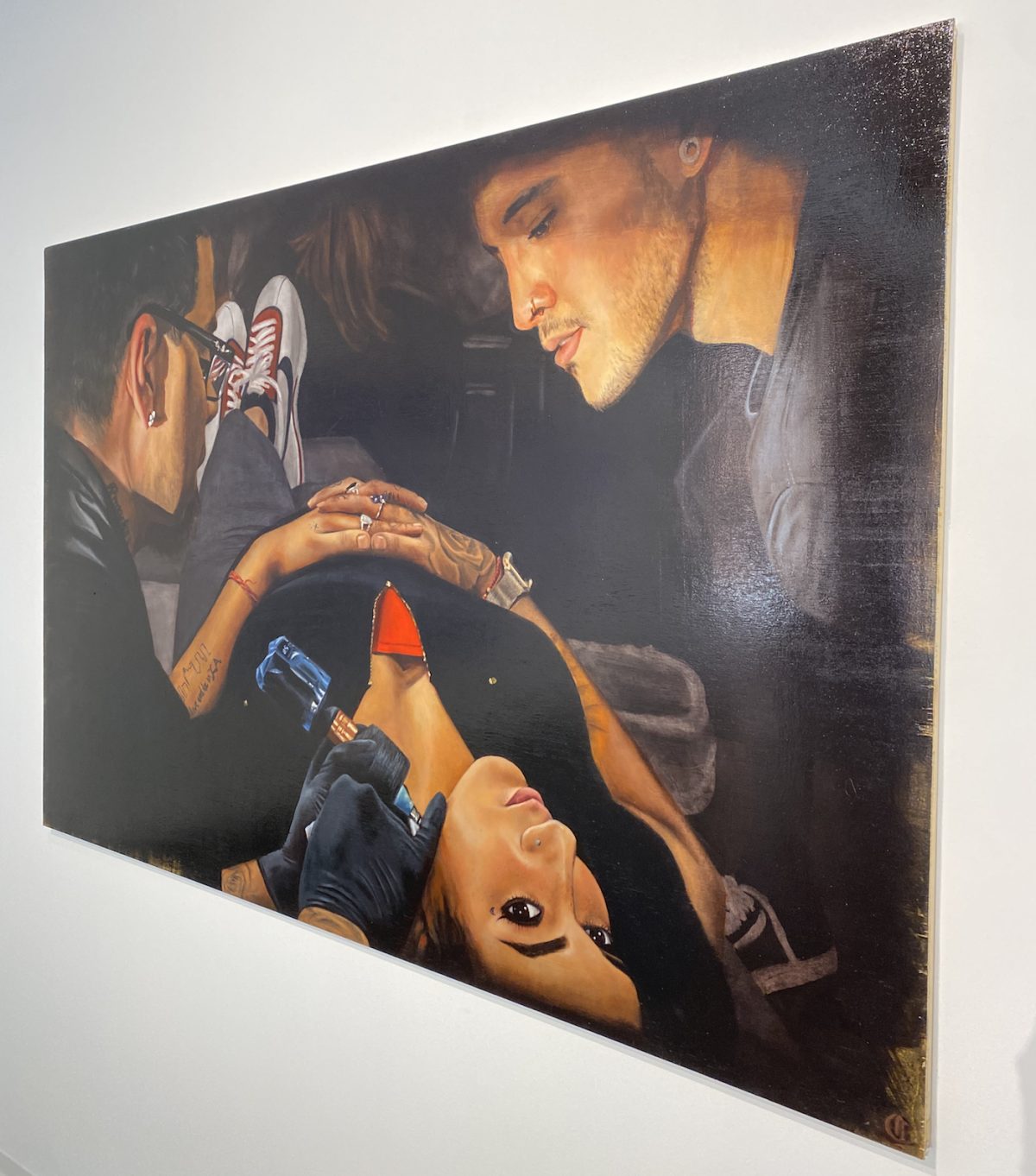
With a successful career as a tattoo artist and a background in “fine” arts, Danie Cansino’s work pokes holes in the high art / low art dichotomy. Her oil on plywood paintings depict tattoo parlor scenes with the gravitas and dramatic chiaroscuro of Caravaggio or Rembrandt. Instead of period figures however, her subjects are her friends, colleagues, and herself. Alongside these monumental works are ballpoint pen on paper works that elevate the medium familiar to any daydreaming student. A sweeping hillside landscape depicts Chavez Ravine, the predominantly Latinx neighborhood where Cansino’s great-grandfather lived, that was razed in 1959 to make way for Dodger Stadium. Titled “Dodger Blue” the work speaks to the complicated relationship that many Latinx Angelenos have with the baseball team: a connection to the contemporary Dodgers mixed with unease at the historical trauma inflicted upon their community.
José Guadalupe Sánchez III: Para Acompañar, USC Roski

José Guadalupe Sánchez III makes visible the familial bonds that connect the living with those who’ve passed on. A painting on the wall composed of overlapping architectural renderings reveals a pastel palimpsest of family homes, collapsing time and space. Freestanding panels depicting generations of matriarchs serve as altars, with a small ledge at their base for offerings. Visitors to “Para Acompañar” were asked to bring something to leave for the ancestors portrayed in Sánchez’s paintings. In the center of the gallery, a monitor documents a performance in which Sánchez donned a large hat, while the audience repeatedly asked “How are you Jose?”, forming new strands of extra-familial connection.
Hings Lim: Imperceptible: machine, animal, plant, stone, skull, USC Roski

The centerpiece of Hings Lim’s show is an interactive projection of a CGI monolith poking through the clouds. The shape responds to sound, becoming a quivering mass before collapsing as the visitors talk or shout, an enigmatic but playful interpretation of our relationship to authority. The computer running the simulation sits on an imposing sentinel-like pedestal, an analog foil for the digital tower. Other works in the show probe history, ritual, and what it means to be human through a deft mix of media, from candles cast from prehistoric stone tools to a ghostly projection of an early hominid skull floating behind a set of colonial-era doors, a reflection on Lims’s native Malaysia, once a British colony, and his own identity as a Malaysian of Chinese descent.
Diane Williams: The Precarious Life of the Parol, USC Roski
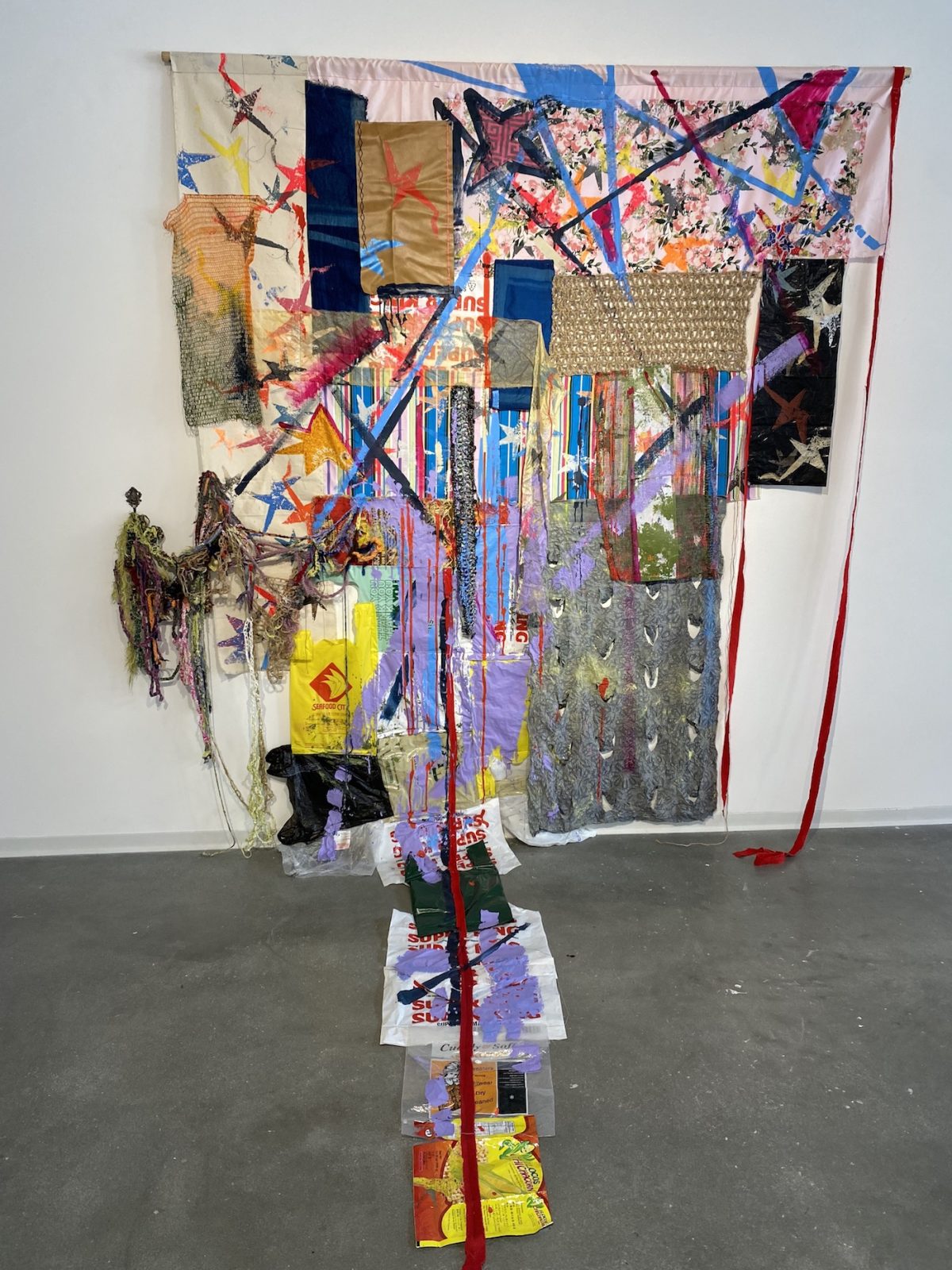
Diane Williams’s thesis show emerged from her research into the origins of the parol, a star-shaped Christmas lantern from the Philippines. The resulting woven and collaged textile works capture the challenges in tracking down its provenance through the Philippines’s tangled colonial history, and the unstable concept of authenticity. Incorporating patterned swatches of vibrant fabric from her mother’s dresses, food packaging from Philippine snacks, plastic bags, and even small Santo Niño dolls, the assemblages bust out of their frames and spill onto the floor, resisting neatly defined borders. Silkscreened images of stars reappear atop the riotous combinations, an ever-elusive cypher.
John Burtle, UC Riverside

John Burtle’s practice is defined by humor, collaboration, and generosity — his left arm became the site for Visitor Welcome Center after the Koreatown gallery was displaced by fire, and he frequently alters the spelling of his name (it’s listed as both “John Bordal” and “Joan Bordal” in exhibition materials). His contributions to Bag of Cats 2 perfectly capture this spirit. “Studio Scrapbook 2019-2021” lays open on a table for visitors to leaf through, a compendium of drawings, collages, scraps of fabric, and other ephemera, like peering inside the artist’s mind. Mounted on the wall, “Trash from my floor as the stars for you” (2011/2021) is just that, bits of trash laid out like constellations, giving cosmic significance to the detritus of artmaking.
Joshua Schaedel, UC Riverside

In two large photographs, Joshua Schaedel captures a hazy scene of people gazing off at the LA skyline in the distance. “Negatives (Rooftop, Rendering)” is actually a photo of a vinyl wrap surrounding the ground floor of a new development in Downtown LA, an aspirational image depicting potential tenants relaxing on their rooftop garden. In Schaedel’s appropriation, viewers struggle to make sense of what is pictured, a wry metaphor for its unattainability in rapidly gentrifying Los Angeles. On the ground lie three “nuggets,” balled-up vinyl wraps from works that Schaedel exhibited in Bag of Cats 1. Kicking against the flattening and dematerialization of photography in the age of Instagram, Schaedel emphasizes the medium’s objectood by turning the images into lumps, while cheekily hiding what they depict.
Olivia Leiter, UC Riverside
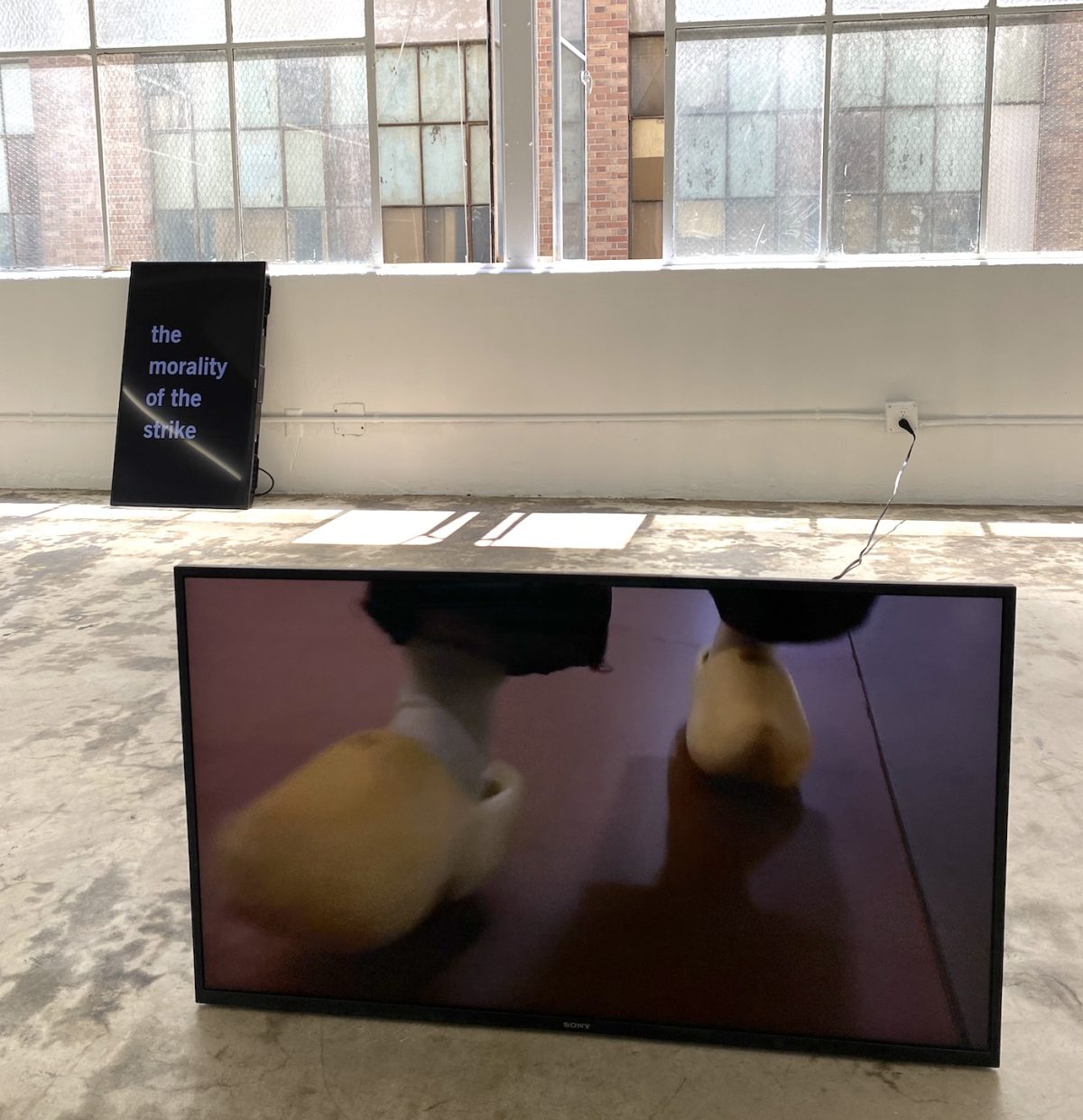
Olivia Leiter’s Sabot (2021) is a two-channel video featuring a close-up of feet noisily walking in wooden clogs paired with text from labor leader Elizabeth Gurley Flynn’s 1916 treatise on sabotage, a word whose etymology can be traced back to the wooden shoes, or sabots, that workers collectively stomped in to disrupt production. Leiter stages her own one-woman protest, wearing her clogs to sites of finance and commerce in LA such as malls and Metro stops, a surreptitious disturbance and call for collaborators.
Bingyang Liu, UC Riverside
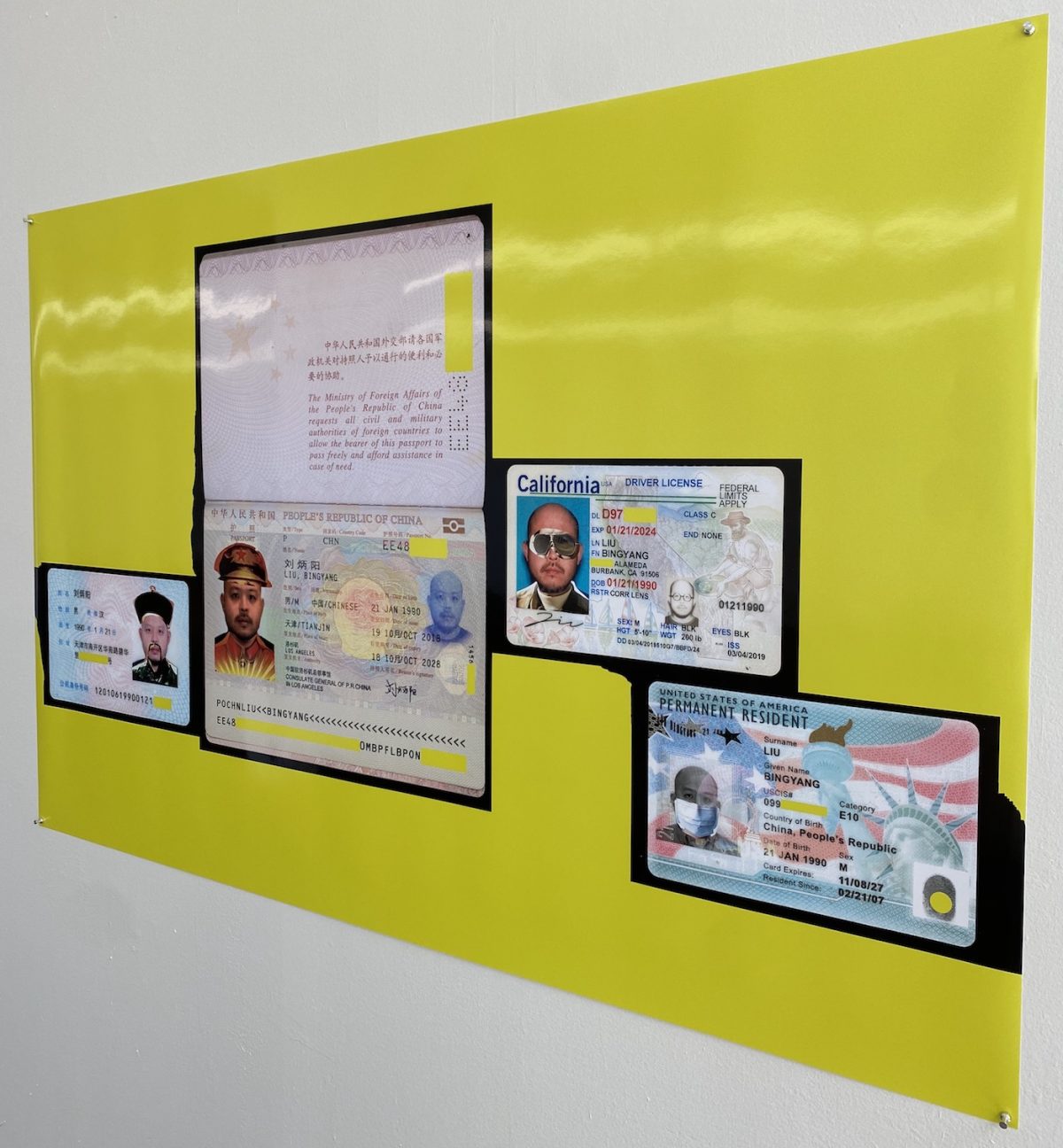
Bingyang Liu’s “Yellow Peril” is a large inkjet print featuring four forms of ID the artist uses. Onto each, the Chinese-born artist has awkwardly photoshopped different attributes: sunglasses onto his California driver’s license, Communist Chinese military garb onto his Chinese passport, a face mask onto his US permanent resident card. The humorous additions speak to the slipperiness of his identity as a Chinese artist residing in the US. “Měi guó rén” (American person or people) is a video documentation of a book Lui made based on Robert Frank’s seminal 1958 photobook The Americans. Unable to access the book’s content via online search engines in China, he instead searched for each photo’s title — Charity Ball, American Buffet, etc. — and created a book modeled on Frank’s with grids of his search results overlaid on Frank’s images. True to the collaborative spirit of this group, Schaedel said he plans to print a larger run of Liu’s book through his publishing company Fulcrum Press, adding another link to Liu’s global game of telephone.
0 Commentaires